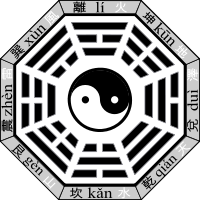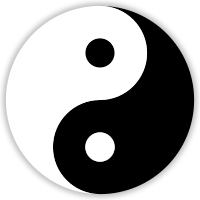|
Home: Religion: Taoism: Symbols, Symbology.
Taoism Symbols
 The yin and yang is a well known symbol used in Taoism. The yin and yang is a well known symbol used in Taoism.
|
|
![]()
Taoist SymbolismThe Taijitu or yin and yang symbol as well as the Ba gua or Eight Trigrams are associated with Taoist symbolism. While almost all Taoist organizations make use of the yin and yang symbol, one could also call it Confucian, Neo-Confucian or pan-Chinese. The yin and yang make a backwards "S" shape, with yin on bottom. One is likely to see this symbol as decorations on Taoist organization flags and logos, temple floors, or stitched into clerical robes. According to Song Dynasty sources, it originated around the 10th century. Previously, yin and yang were symbolized by a tiger and dragon. |
 Bagua with name and nature. Bagua with name and nature. |
Yin and Yang
Yin yang are complementary opposites within a greater whole. Everything has both yin and yang aspects, although yin or yang elements may manifest more strongly in different objects or at different times. Yin yang constantly interacts, never existing in absolute stasis. The concept of yin and yang is often symbolized by various forms of the Taijitu symbol, for which it is probably best known in western cultures. The nature of yin–yang
The nature of yin–yang
In Taoist philosophy, yin and yang arise together from an initial quiescence or emptiness, and continue moving in tandem until quiescence is reached again. For instance, dropping a stone in a calm pool of water will simultaneously raise waves and lower troughs between them, and this alternation of high and low points in the water will radiate outward until the movement dissipates and the pool is calm once more. Yin–yang, thus, are always opposite and equal qualities. Further, whenever one quality reaches its peak it will naturally begin to transform into the opposite quality: grain that reaches its full height in summer (fully yang) will produce seeds and die back in winter (fully yin) in an endless cycle. It is impossible to talk about yin or yang without some reference to the opposite, since yin–yang are bound together as parts of a mutual whole. A race with only men or only women would disappear in a single generation; but men and women together create new generations that allow the race they mutually create (and mutually come from) to survive. The interaction of the two gives birth to things.
Yin and yang transform each other: like an undertow in the ocean, every advance is complemented by a retreat, and every rise transforms into a fall. Thus, a seed will sprout from the earth and grow upwards towards the sky – an intrinsically yang movement. Then when it reaches its full potential height it will fall.
![]()
Ba Gua
 The ba gua literally "eight symbols" are eight diagrams used in Taoist cosmology to represent the fundamental principles of reality, seen as a range of eight interrelated concepts. Each consists of three lines, each either "broken" or "unbroken," representing a yin line or a yang line, respectively. Due to their tripartite structure, they are often referred to as "trigrams" in English.
The ba gua literally "eight symbols" are eight diagrams used in Taoist cosmology to represent the fundamental principles of reality, seen as a range of eight interrelated concepts. Each consists of three lines, each either "broken" or "unbroken," representing a yin line or a yang line, respectively. Due to their tripartite structure, they are often referred to as "trigrams" in English.
The trigrams are related to taiji philosophy and the wu xing, or "five elements". The relationships between the trigrams are represented in two arrangements, the Primordial, "Earlier Heaven" and the Manifested "Later Heaven" bagua. The trigrams have correspondences in astronomy, astrology, geography, geomancy, anatomy, the family, and elsewhere.
The ancient Chinese classic I Ching consists of all 64 possible pairs of trigrams (called "hexagrams") and commentary on them.
The eight trigrams are:
- Qián - "Heaven"
- Duì - "Lake/Marsh"
- Lí - "Fire"
- Zhèn - "Thunder"
- Xùn - "Wind"
- Kǎn - "Water"
- Gèn - "Mountain"
- Kūn - "Earth"
Bagua Map and Feng Shui
A bagua map is a tool used in modern forms of feng shui to map a room or location and see how the different sections correspond to different aspects in one's life. These sections are believed to relate to every area or aspect of life and are divided into such categories as fame, relationships/marriage, children/creativity, helpful people/travel, career, inner knowledge, family/ancestors/health, and wealth/blessings.In this system, the map is intended to be used over the land, one's home, office or desk to find areas lacking good chi, and to show where there are negative or missing spaces that may need rectifying or enhancing in life or the environment.
For example, if the bagua grid is placed over the entire house plan and it shows the toilet, bathroom, laundry, or kitchen in the wealth/blessings area it would be considered that the money coming into that particular environment would disappear very fast, as if to be 'going down the drain.'
![]()
Other Symbols, Rituals
Taoist temples may fly square or triangular flags. They typically feature mystical writing or diagrams and are intended to fulfill various functions including providing guidance for the spirits of the dead, to bring good fortune, increase life span, etc. Other flags and banners may be those of the gods or immortals themselves.A zigzag with seven stars is sometimes displayed, representing the Big Dipper or the "Bushel", the Chinese equivalent. In the Shang dynasty the Big Dipper was considered a deity, while during the Han dynasty, it was considered a qi path of the circumpolar god, Taiyi.
Taoist temples in southern China and Taiwan may often be identified by their roofs, which feature Chinese dragons and phoenixes made from multi-colored ceramic tiles. They also stand for the harmony of yin and yang (with the phoenix being yin). A related symbol is the flaming pearl which may be seen on such roofs between two dragons, as well as on the hairpin of a Celestial Master. In general though, Chinese Taoist architecture has no universal features that distinguish it from other structures.
![]()
Links and Resources
Parts of the above article are licensed under the GNU Free Documentation License. It uses material from Wikipedia. Images courtesy FCIT
![]()
Copyright Important.ca ©. All rights reserved.
